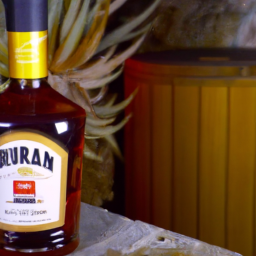Exploring the History of Caribbean Rum: From Sugar Cane to Cocktails
The Caribbean is renowned for its production of rum, a spirit made from sugar cane and its by-products. For centuries, rum has been an integral part of Caribbean culture, with its production and consumption deeply embedded in the region’s history. From its humble beginnings as a by-product of the sugar industry to its current status as a popular cocktail ingredient, rum has come a long way. In this article, we will explore the history of Caribbean rum, from its origins to its current place in the world of cocktails.
Rum has its roots in the Caribbean sugar industry. In the 17th century, sugar cane was introduced to the region, and with it, the production of molasses, a by-product of sugar refining. Molasses was used to make rum, which was then used as a form of currency and as a trade item. As the popularity of rum grew, so did its production, and by the 18th century, rum had become an important part of Caribbean culture.
The production of rum in the Caribbean was further bolstered by the invention of the column still in the 19th century. This new technology allowed for the production of higher-quality rum, which was then exported to Europe and the United States. By the 20th century, rum had become a popular spirit in the United States, with brands such as Bacardi and Captain Morgan becoming household names.
Today, rum is a popular ingredient in cocktails, with classic drinks such as the Mojito and the Daiquiri being made with rum. Rum is also used in a variety of other drinks, from tiki drinks to punches. The popularity of rum has led to the emergence of craft distilleries in the Caribbean, which are producing high-quality rums that are gaining recognition around the world.
From its humble beginnings as a by-product of the sugar industry to its current status as a popular cocktail ingredient, rum has come a long way. Its production and consumption have been deeply embedded in Caribbean culture for centuries, and its popularity continues to grow. Whether you’re sipping a classic rum cocktail or trying a craft rum from a Caribbean distillery, there’s no denying that rum is an integral part of Caribbean culture.
The Different Types of Caribbean Rum and How to Enjoy Them

Caribbean rum is a type of distilled alcoholic beverage made from sugarcane byproducts, such as molasses or sugarcane juice. It is produced in many countries throughout the Caribbean, including Barbados, Jamaica, and the Dominican Republic. Caribbean rum is known for its unique flavor and aroma, which can vary depending on the type of rum and the production process.
There are several different types of Caribbean rum, each with its own distinct flavor and aroma. Light rums are typically light in color and flavor, with a mild sweetness. They are often used in cocktails and mixed drinks. Dark rums are aged for longer periods of time and have a richer, more robust flavor. They are often used in cooking and baking. Spiced rums are flavored with spices such as cinnamon, nutmeg, and vanilla, and are often used in desserts and cocktails.
No matter which type of Caribbean rum you choose, there are several ways to enjoy it. One of the most popular ways to enjoy rum is in a classic rum and Coke. Simply mix one part rum with two parts cola and enjoy. Another popular way to enjoy rum is in a rum punch. This is a mixture of rum, fruit juice, and other ingredients such as lime juice, sugar, and spices.
If you’re looking for a more sophisticated way to enjoy rum, try sipping it neat or on the rocks. Neat means that the rum is served without any mixers or ice. On the rocks means that the rum is served over ice. Both of these methods allow you to appreciate the flavor and aroma of the rum without any distractions.
No matter how you choose to enjoy Caribbean rum, it is sure to be a delicious and enjoyable experience. With its unique flavor and aroma, Caribbean rum is sure to be a hit at any gathering.
The Rise of Craft Caribbean Rum: How Small-Batch Distillers are Reviving the Industry
The Caribbean rum industry has seen a resurgence in recent years, thanks to the emergence of small-batch distillers. These craft distillers are reviving the industry by producing high-quality, unique rums that are gaining popularity among rum enthusiasts.
The Caribbean rum industry has a long and storied history. It began in the 1600s when the British and French colonized the region and began producing rum from sugarcane. Over the centuries, Caribbean rum became a staple of the region, with many countries developing their own unique styles and flavors.
However, in recent decades, the industry has been in decline. Large-scale distilleries have been producing mass-market rums that lack the complexity and flavor of traditional Caribbean rums. This has led to a decrease in demand for Caribbean rum, as consumers have turned to other spirits.
Fortunately, small-batch distillers are now reviving the industry. These craft distillers are producing high-quality, unique rums that are gaining popularity among rum enthusiasts. These craft rums are made with traditional methods and ingredients, and they often feature unique flavors and aromas.
These craft rums are also helping to revive the Caribbean rum industry as a whole. By producing high-quality rums, craft distillers are helping to raise the profile of Caribbean rum and attract new consumers. This is helping to increase demand for Caribbean rum, which is leading to more investment in the industry.
The rise of craft Caribbean rum is a welcome development for the industry. These small-batch distillers are producing unique rums that are helping to revive the industry and attract new consumers. As the industry continues to grow, it is likely that craft Caribbean rum will become an increasingly important part of the rum market.
